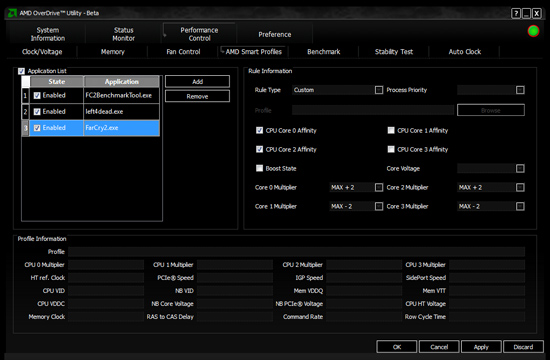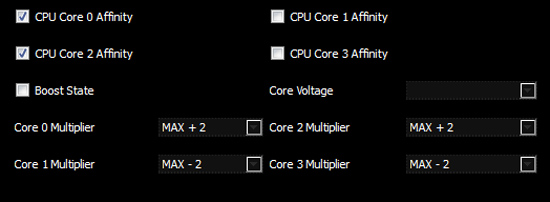AMD's Phenom II X4 955 Black Edition
by Anand Lal Shimpi on April 23, 2009 12:00 AM EST- Posted in
- CPUs
The Software Answer to Intel’s Turbo Mode
The Core i7 has its Turbo Mode. When only one core is active, power is shut off to all other cores and the active one can run at higher clock speeds. Even when all four cores are active, as long as the processor isn’t running too hot, the entire chip can run at a higher frequency. The default turbo speeds for the three i7s out on the market are listed below:
| Processor | Stock Clock Speed | Max Turbo (All Four Cores Active) | Max Turbo (One Core Active) |
| Intel Core i7-965 | 3.20GHz | 3.33GHz | 3.46GHz |
| Intel Core i7-940 | 2.93GHz | 3.06GHz | 3.20GHz |
| Intel Core i7-920 | 2.66GHz | 2.80GHz | 2.93GHz |
Turbo mode is an interesting concept because it allows end users to experience higher performance without ever having to even know about overclocking. In its first incarnation on Nehalem, Intel was quite conservative with how far they pushed Turbo. Given that our Core i7 920 had no problems running at up to 3.8GHz without increasing its core voltage, I’d say that Intel could stand to be a bit more aggressive with its turbo modes.
Note that in all of our multithreaded tests, the Core i7 has no problems running at its “turbo” frequency. In other words, the i7-920 runs at 2.80GHz far more frequently than it runs at 2.66GHz.
AMD unfortunately does not have a similar capability in its processors. Intel dedicated around 1M transistors to an on-die microcontroller called the PCU (Power Control Unit). The Core i7’s PCU tracks power consumption and manages clock speeds and voltages to ensure that the i7 always delivers the best performance when you need it, and the lowest power consumption when you don’t.
AMD didn’t go in and introduce any major architectural changes in the Phenom II X4 955 and most likely won't for a while. Instead, AMD is hoping to deliver a turbo-like feature in software.
The software is AMD’s Overdrive Utility 3.0 and the feature is called AMD Smart Profiles.

It works like this: you select an executable, and then using AOD3 you can set what cores that executable should run on and what clock speeds those cores should run at. AMD will have predefined profiles for various games but you can also create your own profiles.

Since the majority of desktop applications aren’t multithreaded, you’d stand to benefit from running two of your cores at a higher frequency and dropping the clock speed on the remaining two cores. That way you could keep power consumption unchanged, while improving performance.
It does work, I ran a quick test on Left 4 Dead and Far Cry 2:
| Processor | Left 4 Dead | Far Cry 2 |
| Smart Profiles Enabled | 124.1 fps | 53.3 fps |
| Smart Profiles Disabled | 121.4 fps | 51.2 fps |
| Performance Improvement | 2.2% | 4.1% |
In these cases the games were forced to run on two cores specifically (at least the .exe files) and those two cores were overclocked by 400MHz, while the remaining two cores were underclocked by 400MHz. The end result was that performance improved by 2% in Left 4 Dead and 4% in Far Cry 2.
There’s obviously more flexibility with AMD’s method than Intel’s and you could potentially get a much greater performance improvement. There are a couple of downsides. For starters, there’s no guarantee of stability but if you keep the overclocks mild and/or accompany them with a corresponding increase in core voltage then you can minimize that risk. The other obvious downside is that for the majority of applications and games you’ll have to create profiles manually. Honestly I’d prefer if the CPU did the work for me, but if you enjoy customizing your system then you’ll feel right at home with AOD3’s Smart Profiles.
AMD will add new profiles as time goes on. AMD does have plans for a turbo mode in future microprocessors, but we won’t see them until 2011.










65 Comments
View All Comments
strikeback03 - Thursday, April 23, 2009 - link
Well, the most expensive X58 board is over $400, while the cheapest AM2+ boards are under $50, do you want them to say the range is over $350? I'd guess the thinking behind that statement was that you would pair the most expensive processor AMD sells with a higher-end board - the AMD boards top out at about $190, about where the i7 boards start (ignoring rebates).just4U - Friday, April 24, 2009 - link
It's the minimum entry level into each that I think most people would be curious about. The higher end stuff can really skyrocket the price after all and I am pretty sure it would be filled with features not likely to interest the majority.strikeback03 - Friday, April 24, 2009 - link
Again though, those who are looking to buy the 955 are probably interested in some of the stuff the better boards offer. Considering the performance available form the 720 or 940 at cheaper prices, I am still doubtful how many people would go for the 955 and the cheapest motherboard possible.duploxxx - Thursday, April 23, 2009 - link
arrgghh stupied newegg search engine and no edit on anandtech poststhe msi costs 131, that is still 40$
http://www.newegg.com/Product/Product.aspx?Item=N8...">http://www.newegg.com/Product/Product.aspx?Item=N8...
ssj4Gogeta - Thursday, April 23, 2009 - link
AMD is getting close and that's a good thing as all of us know. Not that I use AMD, but low prices on Intel chips is good.But I think that AMD is soon going to be left behind again when Intel introduces the affordable i5. From what I know the only difference between i7 is that i5 has only 2 channels of RAM and it has the PCIe controller on the package. Surely it won't be too far behind i7 in terms of performance.
Also can someone clarify whether i5 will be using QPI?
duploxxx - Thursday, April 23, 2009 - link
well then you are one of the so many that have an issue about best price/performance and waht about know, all non i7 buyers are better of pricewise with a AMD based system unless you really want to stick with dualcore for no future at all... . On what planet were you living from 2003-2006 when AMD was the better choice of buying instead off Intel.Sagath - Thursday, April 23, 2009 - link
Yes, and No. It uses a QPI derivative called CPI if my memory serves correct.I dont remember where I read this, so I cannot referance you to it. Nor do I know the difference between the two. Sorry.
knutjb - Thursday, April 23, 2009 - link
AMD still has a long way to go but they are improving. I am glad to see them improve since it pressures Intel to lower prices that benefit the majority of us who can't afford Intel's high end. The closer the competition the better for the consumer, we can't afford to see AMD die off as some joke about.Griswold - Thursday, April 23, 2009 - link
"..but as applications and workloads become more threaded the i7 could be a wiser long-term purchase. "I bought my Q6600 in 2007 and for good reasons (then). I made good use of the four cores - but I've been hearing the above quoted sentence sind 2007 and before but it still has not become true and probably wont before quite some time.
Where is this "more threaded" and when will it actually arrive? :P
The situation is such, that I'm definitely going to wait for i5 for the next upgrade and may grab a dualie with hyperthreading, simply because theres only so much I need 4 physical cores for now so it starts to seem like 2 cores plus the two additional logic cores is the more cost efficient and rational way.
An i7 is definitely not going to be my thing - I just dont need 8 logical cores enough to make it worthwhile.
But maybe I can stick to my trusty Q6600 long enough for AMD to serve me the perfect solution, maybe with Bulldozer?
ssj4Gogeta - Thursday, April 23, 2009 - link
Why do you look at the number of cores and decide? Look at the performance numbers and decided.Besides Hyper threading can't deliver performance boost in all applications. So if you're going 2 cores with hyperthreading you may not see as much performance as 4 physical cores in many apps. You need to look at performance numbers for the apps you most use, not the number of cores.